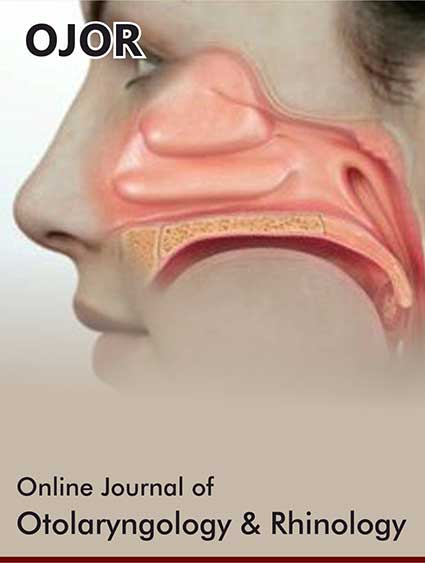 Research Article
Research Article
Alar Spanning Suture: How to Get A Predictable Outcome in Time
Benedetta Fanelli MD* and Mauro Tarallo Prof.
Plastic and Reconstructive Unit, Ausl Latina, Sapienza Università di Roma Polo Pontino-Viale Pier Luigi Nervi, Latina, Italy
Benedetta Fanelli MD, Plastic and Reconstructive Unit, Ausl Latina, Sapienza Università di Roma Polo Pontino-Viale Pier Luigi Nervi, Latina, Italy
Received Date: November 29, 2024; Published Date: December 06, 2024
Abstract
Introduction: this study aimed to evaluate the long-term nasal tip contouring using alar spanning suture with permanent sutures.
Methods: The study included 30 Caucasian patients who underwent primary rhinoplasty using alar spanning suture for nasal tip projection between May 2020 and December 2021. The surgical procedure involved making a closed rhinoplasty.
Results: Spanning sutures technique was shown to be effective in providing stable tip projection and definition. Rhinoplasty Outcome Evaluation (ROE) questionnaire has been used to evaluate patient satisfaction and outcome after 18 months from surgery.
Keywords: Alar spanning suture; permanent sutures rhinoplasty
Introduction
Tip projection and definition has been always a challenge in rhinoplasty, due to different patient anatomy of alar cartilages and quality and thickness of the overlying skin [1].
Over the time several techniques have been described to improved nasal tip shape and definition, but most of them are based on resection of the alar cartilages, with possibility of postoperative scarring and impredictable results in time. Other based on contour graft can be visible especially in patients with thin skin and partially adsorbed over time leading to asymmetries [2].
The spanning suture is a technique used to reshape and refine the nasal tip that is gaining popularity both with traditional rhinoplasty and preservation rhinoplasty. The spanning suture technique involves the use of sutures (stitches) to manipulate the nasal tip cartilages and achieve the desired contour. Different materials have been used to performed the spanning suture. Our purpose is to evaluate the long-term result with the use of permanent sutures.
Materials and Methods
This prospective study has been performed enrolling 30 patients between May 2020 and December 2021.
This included Causasian patients that had surgery only for closed primary rhinoplasty. The surgeon first evaluates the patient’s nasal anatomy and discusses their goals for the procedure. This assessment includes considering the size, shape, and position of the nasal tip.
Pictures had been made in at the time of first consultation, after three mouth post surgery, six mouth and at the end of the study.
All procedures had been performed under general anesthesia with local infiltration. In all patients intercartilagineus incision has been used combined with transfixion incision in order to have full access to the nasal dorsum ant tip cartilages.
All patients underwent full rhinoplasty or rhinoseptoplasty depending on the case.
Mucosal side has been dissected for a few millimetres for a better exposure of the cephalic part of lower cartilages, then 4/0 Ethilon nylon suture (polyamide) has passed through a portion of a right lateral crus and then through the left one and tied over the dorsal septum without crossing the septum (Figure 1).
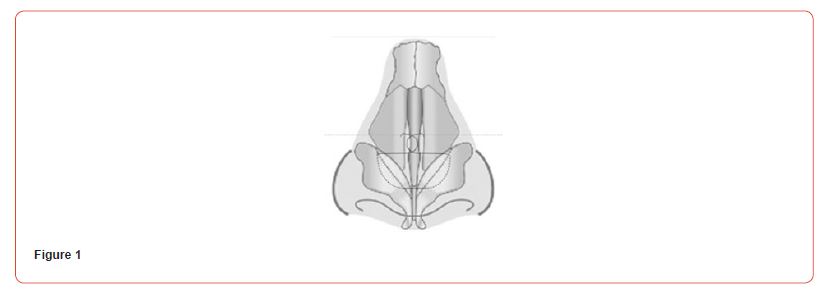
In case of wide lateral cartilage conservative trimming is performed before suturing.
All patients have been treated by the same surgeon. The average procedure time ranged 45 minutes and 1 our and half. Packing and splint are placed after suturing the incisions.
Width of middle vault is taken by caliber at the time of splint removal, at three month, six month and at the end of the study in order to check stability of the result in time.
Patients are required to fill up the Roe Questionnaire (Figure 2) at follow up when postop pictures are taken.
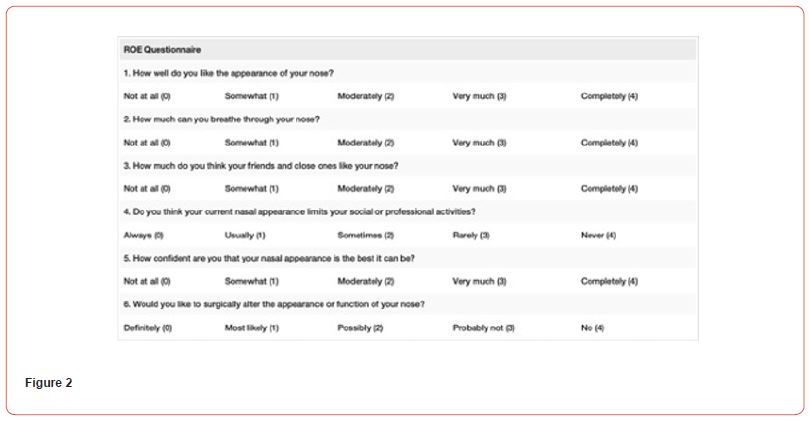
Results
Age patients ranged from 18 to 40 years old with an average of 24,93 years. The number of female patients was 24 (80%) and six males (20%).
Preoperative middle vault width ranged between 18,0 and 21,0mm, postoperative measures, after splint removal, varied between 9,0 and 11,0mm.
Measures have shown a stable result at three months follow up. Two patients developed a 1mm sligthly difference in width at six months with a final 18 months follow up showing a stable result compared with a previous one.
None of the patients that went through rhinoplasty, only for aesthetic reasons, referred functional problems after the spanning suture technique.
The average preoperative ROE score 32,71 and the postoperative one 89,32. A statically significant improvement was observed in ROE score for the whole sample (P0.05).
Case 1
A 24 years old female Caucasian patient with wide tip. Postoperative picture shoes a significative improvement of middle vault at 18 months post op. Rhinoplasty with spanning suture have been performed with 4/0 Ethilon nylon suture (Figure 3a-b).
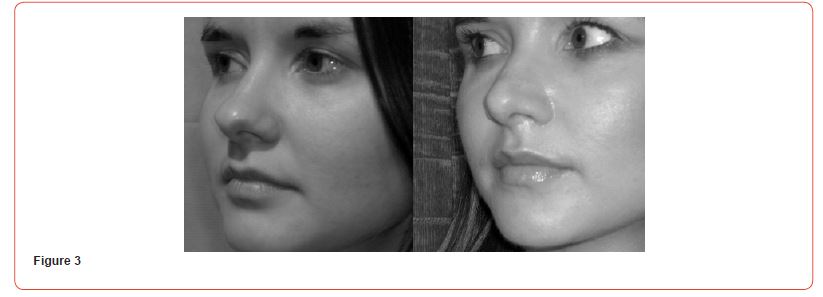
Case 2
A 28 years old female patient non Caucasian with crooked nose and wide middle vault. Patient went through full rhinoseptoplasty with spanning suture performed with 4/0 Ethilon nylon suture (Figure 4 a-b).
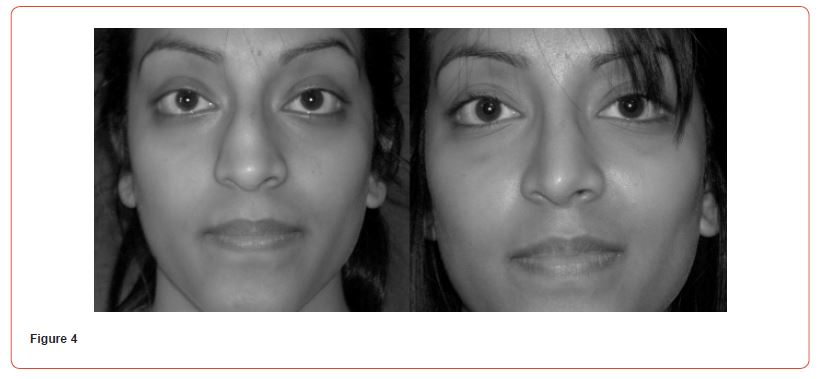
Discussion
Spanning suture is very effective in narrowing middle vault without cartilage resection and these time is one of the main steps of preservation rhinoplasty
This suture changes also excessive convexity of lower cartilages in concavity giving better shape to middle vault and nasal tip.
Different materials have been used in time from different authors without a clear evidence about which one can be the most reliable one [3-5].
Purpose of this study is to demonstrate how the use of a permanent suture can be reliable for a stable result in time.
Only two cases (6,6%) had a minimal change of middle vault (1mm) width at six months, but the shape has been stable in time.
Moderate trimming in our opinion has been very effective in keeping the stability of the result other then traditional spanning technique were sutures are just passed through cartilages. The trimming allows a firm grip of suture trough the edge of the remaining cartilages.
Conclusion
Nasal tip definition is one of the key points of rhinoplasty and a stable result is gool of any surgeon. According to the author’s experience, a permanent suture is very reliable for getting a longterm result in spanning suture technique even if a wider series of patients should be necessary with a longer follow up for a definitive assessment.
Acknowledgement
None.
Conflict of Interest
The authors declare that they have no conflict of interest.
Financial Disclosure Statement
No funding was received for this article.
References
- Daniel RK (1987) Rhinoplasty: creating an aesthetic tip: preliminary report Plast Reconstr Surg 80: 775-783.
- Baker SR (2000) Suture countouring of the nasal tip. Arch Facial Plast Surg 2: 34-42.
- Cakmak O, Akkuzu G (2011) Primary rhinoplasty and suture techniques.
- Griber RP, Eintraub J, Pomerantz J (2008) Suture techniques for the nasal tip. Aesthetic Surg J 28: 92-100.
- Cagici A, Cakmak O, Bal N, Yavuz H, Tuncer I (2008) Effects of different suture materials on cartilage reshaping. Arch Facial Plast Surg 10:124-129.
-
Benedetta Fanelli MD* and Mauro Tarallo Prof. Alar Spanning Suture: How to Get A Predictable Outcome in Time. On J Otolaryngol & Rhinol. 7(3): 2024. OJOR.MS.ID.000662.
-
Rhinoplasty, Nasal tip, Middle vault, Surgery, Nasal anatomy, Post surgery, Dorsal septum, Aesthetic reasons, Nose
-

This work is licensed under a Creative Commons Attribution-NonCommercial 4.0 International License.



